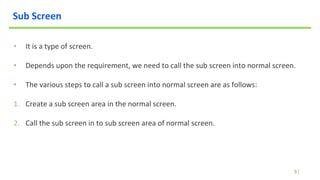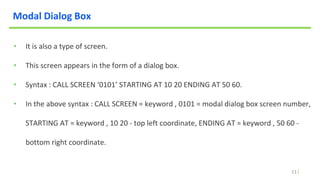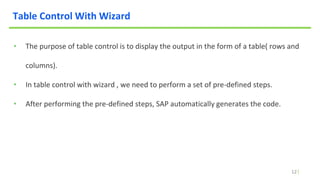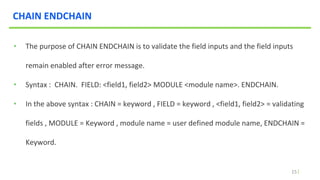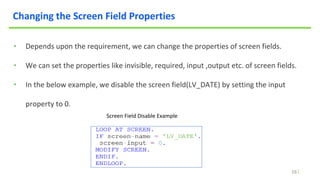SAP ABAp module Pool programming give by Rahul Mehta
- 2. 2 Introduction ▪ It is also called as dialog programming. ▪ It is a pool of modules like screens, includes, transactions etc. ▪ A module pool is mainly a pool of screens. ▪ The type of module pool program is ‘M’. ▪ The difference between executable program and module pool program is - An executable program runs independently, whereas a module pool program can not run independently. A transaction code is required to run a module pool program.
- 3. 3 Screen Types ▪ There are 4 types of screen. 1. Normal screen 2. Subscreen 3. Modal dialog box 4. Selection screen
- 4. 4 Tabs(Parts) of Screen ▪ A screen has 3 parts. 1. Attributes - It provides the generic information like description, type of screen, package etc. of that screen. 2. Element list - It provides the list of elements available on that screen. 3. Flow logic - It’s purpose is to write the logic.
- 5. 5 Module Pool Events ▪ There are 4 module pool events. 1. Process before output(PBO) 2. Process after input(PAI) 3. Process on value request(POV) 4. Process on help request(POH)
- 6. 6 Module Pool Events 1. Process before output - This event calls before displaying a particular screen. 2. Process after input - This event calls after performing some action on a particular screen. 3. Process on value request - This event calls when we click F4 on a field of a screen. 4. Process on help request - This event calls when we click F1(technical information) on a field of a screen.
- 7. 7 Module Pool Events(Contd.) Imp point : Process before output and process after input are the default events available in the flow logic tab of a screen.
- 8. 8 Screen Painter ▪ We can design the layout through screen painter. ▪ We can open the screen painter by clicking on the layout button of a screen. ▪ We can open the screen painter through transaction code SE51 also. ▪ We can design the various layout elements through screen painter like - text field, input/output field , checkbox , push button , tabstrip with wizard , tablecontrol with wizard , subscreen area , custom control etc.
- 9. 9 Sub Screen • It is a type of screen. • Depends upon the requirement, we need to call the sub screen into normal screen. • The various steps to call a sub screen into normal screen are as follows: 1. Create a sub screen area in the normal screen. 2. Call the sub screen in to sub screen area of normal screen.
- 10. 10 Sub Screen (Contd.) • Syntax to call subscreen into normal screen : CALL SUBSCREEN <sub> INCLUDING SY- REPID '0101’. • In the above syntax : CALL SUBSCREEN = keyword , <sub> = sub screen area name, INCLUDING = keyword , SY-REPID - system variable for report id(report name) , 0101 = sub screen number.
- 11. 11 Modal Dialog Box • It is also a type of screen. • This screen appears in the form of a dialog box. • Syntax : CALL SCREEN ‘0101’ STARTING AT 10 20 ENDING AT 50 60. • In the above syntax : CALL SCREEN = keyword , 0101 = modal dialog box screen number, STARTING AT = keyword , 10 20 - top left coordinate, ENDING AT = keyword , 50 60 - bottom right coordinate.
- 12. 12 Table Control With Wizard • The purpose of table control is to display the output in the form of a table( rows and columns). • In table control with wizard , we need to perform a set of pre-defined steps. • After performing the pre-defined steps, SAP automatically generates the code.
- 13. 13 Tab Strip With Wizard • The purpose of tab strip is to display the output in the form of tabs. • In tab strip with wizard , we need to perform a set of pre-defined steps. • After performing the pre-defined steps, SAP automatically generates the code. • For every tab SAP generates a sub screen.
- 14. 14 AT EXIT-COMMAND • AT EXIT-COMMAND is used to leave the current screen without the automatic input check take place. • We need to take the function type of the button = ‘E’(exit). • Syntax : MODULE <module name> AT EXIT-COMMAND. • In the above syntax : MODULE = keyword , <module name> = user defined module name , AT EXIT-COMMAND = keyword.
- 15. 15 CHAIN ENDCHAIN • The purpose of CHAIN ENDCHAIN is to validate the field inputs and the field inputs remain enabled after error message. • Syntax : CHAIN. FIELD: <field1, field2> MODULE <module name>. ENDCHAIN. • In the above syntax : CHAIN = keyword , FIELD = keyword , <field1, field2> = validating fields , MODULE = Keyword , module name = user defined module name, ENDCHAIN = Keyword.
- 16. 16 Changing the Screen Field Properties • Depends upon the requirement, we can change the properties of screen fields. • We can set the properties like invisible, required, input ,output etc. of screen fields. • In the below example, we disable the screen field(LV_DATE) by setting the input property to 0. Screen Field Disable Example
- 17. 17 Q & A What are the 4 parts of GUI status? Answer : Menu bar, Function Keys, Title bar, Application toolbar. What is the transaction code to create transaction codes? Answer : SE93 What is the system variable for user command which captures the value of function code? Answer : SY-UCOMM.
- 18. 18 Q & A What is the significance of leave to screen 0? Answer : Go to the previous stacked screen. What is the difference between CALL SCREEN <screen no> and LEAVE TO SCREEN <screen no>? Answer : CALL SCREEN <screen no> calls the specified screen by adding the specified screen to the stack, whereas LEAVE TO SCREEN <screen no> calls the specified screen by replacing the last stacked screen.
- 19. 19 Thank You








